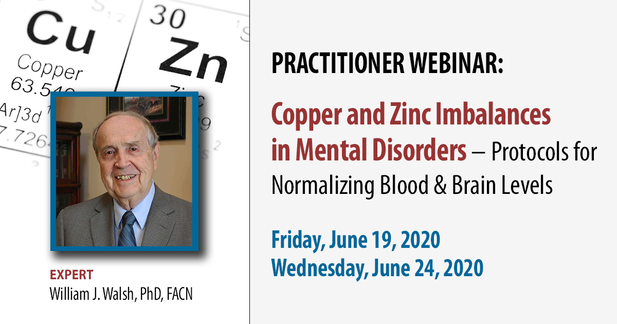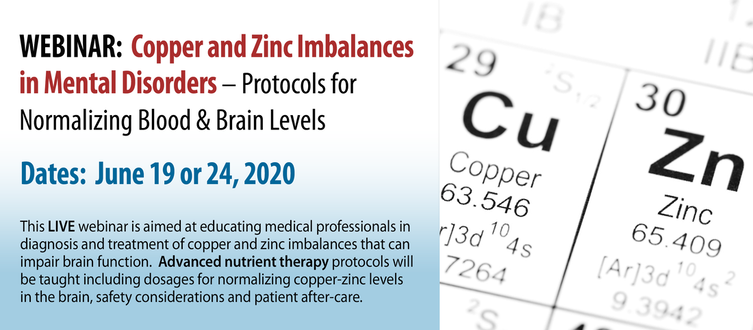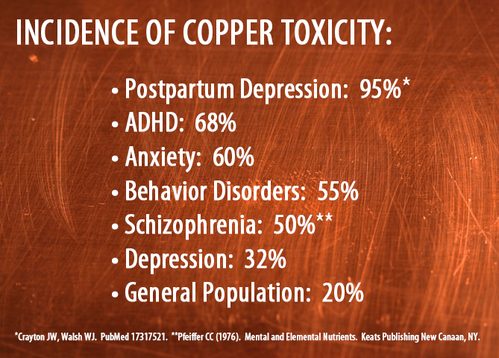Affiliate Promotional Center
⬇ SAMPLE EMAIL COPY ⬇
Dear Community,
There's a common misconception in the functional medicine community that the best way to diagnose copper toxicity is to perform a hair tissue mineral analysis. However, serum copper and ceruloplasmin are the most reliable assays in determining the percentage of "free" copper. A high percentage of unbound "free" copper is an indicator of copper overload and oxidative stress.
Copper pushes the conversion of dopamine into norepinephrine which can short-circuit thought processes in the brain, and lead to anxiety, brain fog, hyperactivity, nervousness or irritability. Imbalances in these important neurotransmitters have been associated with ADHD, behavior disorders, violent behavior, depression including postpartum.
If you are a psychiatrist, integrative medical doctor, naturopathic physician, PA or nurse practitioner – Dr. William J. Walsh, an internationally recognized expert on biochemical imbalances is offering an educational webinar – Copper and Zinc Imbalances in Mental Disorders: Protocols for Normalizing Blood & Brain Levels. This is an important opportunity to learn how diagnosis and treat copper and zinc imbalances that impair brain function.
This two-hour interactive LIVE webinar will cover:
BONUS: A 25+ page Copper-Zinc Reference Document which includes dosages for normalizing copper-zinc levels, safety considerations and patient after-care.
The two-hour interactive webinar is being offered on two dates: Friday, June 19 at 11:00 a.m. CDT and Wednesday, June 24th at 7:00 p.m. CDT.
⟶ Click here [ INSERT YOUR AFFILIATE LINK ] to register and to learn more!
Please feel free to share this information with your community of healthcare practitioners.
In health,
Your Name
Dear Community,
There's a common misconception in the functional medicine community that the best way to diagnose copper toxicity is to perform a hair tissue mineral analysis. However, serum copper and ceruloplasmin are the most reliable assays in determining the percentage of "free" copper. A high percentage of unbound "free" copper is an indicator of copper overload and oxidative stress.
Copper pushes the conversion of dopamine into norepinephrine which can short-circuit thought processes in the brain, and lead to anxiety, brain fog, hyperactivity, nervousness or irritability. Imbalances in these important neurotransmitters have been associated with ADHD, behavior disorders, violent behavior, depression including postpartum.
If you are a psychiatrist, integrative medical doctor, naturopathic physician, PA or nurse practitioner – Dr. William J. Walsh, an internationally recognized expert on biochemical imbalances is offering an educational webinar – Copper and Zinc Imbalances in Mental Disorders: Protocols for Normalizing Blood & Brain Levels. This is an important opportunity to learn how diagnosis and treat copper and zinc imbalances that impair brain function.
This two-hour interactive LIVE webinar will cover:
- The Role of Zinc and Copper in Behavior Disorders, ADHD, Anxiety, Depression, and Other Brain Disorders
- Symptoms and Traits of Zinc Depletion and Copper Overload
- Interpretation of Laboratory Results (Copper Serum, Zinc Plasma & Ceruloplasmin)
- Advanced Nutrient Therapy Protocols
- Clinical Outcome Studies
BONUS: A 25+ page Copper-Zinc Reference Document which includes dosages for normalizing copper-zinc levels, safety considerations and patient after-care.
The two-hour interactive webinar is being offered on two dates: Friday, June 19 at 11:00 a.m. CDT and Wednesday, June 24th at 7:00 p.m. CDT.
⟶ Click here [ INSERT YOUR AFFILIATE LINK ] to register and to learn more!
Please feel free to share this information with your community of healthcare practitioners.
In health,
Your Name
⬇ ADDITIONAL COPY ⬇
Dr. William Walsh's massive database of 30,000 patients indicates that copper and zinc imbalances are very common in mental disorders, and normalization of these factors usually provides great improvements. Mainstream medicine needs to become more aware of the importance of these trace metals in physical and mental health. The clinical challenge is to identify patients with Copper and/or Zinc
imbalances, and to provide treatments that normalize blood and brain levels,
Based on Dr. Walsh's studies of 2,800 depressed patients, copper overload tends to be more common in women (96% of subjects) and are more likely to suffer from high anxiety, adrenal fatigue, fibromyalgia or postpartum depression in their child bearing years. A large study by William Walsh and John Crayton reported that depressed women with a history of postpartum depression have significantly elevated serum copper when compared to both non-depressed women.
Another outcome study revealed that 75% of young males with ADD, episodic rage disorder, hyperactivity, destructive and/or assaultive behaviors exhibitor exhibited elevated copper/zinc ratios. Separate outcome studies indicated significant improvements in behavior after normalization of Cu/Zn ratios.
Unfortunately, many persons have a genetic inability to regulate copper levels and a serious copper overload can result. Causes of copper overload range from metallothionein SNP mutations, zinc deficiency, environmental copper exposures, copper-rich foods, birth control pills or copper IUDs, and hormonal therapy.
Incidence of Copper Overload:
*Crayton JW, Walsh WJ. PubMed 17317521.
**Pfeiffer CC (1976). Mental and Elemental Nutrients. Keats Publishing New Canaan, NY.
Dr. Walsh's Related Studies:
Dr. William Walsh's massive database of 30,000 patients indicates that copper and zinc imbalances are very common in mental disorders, and normalization of these factors usually provides great improvements. Mainstream medicine needs to become more aware of the importance of these trace metals in physical and mental health. The clinical challenge is to identify patients with Copper and/or Zinc
imbalances, and to provide treatments that normalize blood and brain levels,
Based on Dr. Walsh's studies of 2,800 depressed patients, copper overload tends to be more common in women (96% of subjects) and are more likely to suffer from high anxiety, adrenal fatigue, fibromyalgia or postpartum depression in their child bearing years. A large study by William Walsh and John Crayton reported that depressed women with a history of postpartum depression have significantly elevated serum copper when compared to both non-depressed women.
Another outcome study revealed that 75% of young males with ADD, episodic rage disorder, hyperactivity, destructive and/or assaultive behaviors exhibitor exhibited elevated copper/zinc ratios. Separate outcome studies indicated significant improvements in behavior after normalization of Cu/Zn ratios.
Unfortunately, many persons have a genetic inability to regulate copper levels and a serious copper overload can result. Causes of copper overload range from metallothionein SNP mutations, zinc deficiency, environmental copper exposures, copper-rich foods, birth control pills or copper IUDs, and hormonal therapy.
Incidence of Copper Overload:
- Postpartum Depression: 95%*
- ADHD: 68%
- Anxiety: 60%
- Behavior Disorders: 55%
- Schizophrenia: 50%**
- Depression: 32%
- General Population: 20%
*Crayton JW, Walsh WJ. PubMed 17317521.
**Pfeiffer CC (1976). Mental and Elemental Nutrients. Keats Publishing New Canaan, NY.
Dr. Walsh's Related Studies:
- Elevated Serum Copper Levels in Women with a History of Postpartum Depression
- Micronutrient Therapy for Violent and Aggressive Male Youth: An Open-Label Trial
- Elevated Blood Copper/Zinc Ratios in Assaultive Young Males
- Reduced Violent Behavior following Biochemical Therapy
- The Effectiveness of Targeted Nutrient Therapy in Treatment of Mental Illness
Affiliate Email & Social Media Banners
| Cu/Zn Webinar Email Banner | |
| File Size: | 195 kb |
| File Type: | png |
| Cu/Zn Webinar Facebook Post | |
| File Size: | 242 kb |
| File Type: | png |
| Cu/Zn Webinar Large Banner | |
| File Size: | 559 kb |
| File Type: | png |
| Copper Toxicity | |
| File Size: | 559 kb |
| File Type: | png |
⬇ DR. WALSH'S QUOTES ON COPPER ⬇
“Excess copper can cause dramatic imbalances in two key neurotransmitters, and may lead to depression or behavioral/learning issues. For example, 68% of all ADHD kids have a tendency for very high levels of copper. Excess copper can cause inattention, anxiety and hyperactivity. Copper is especially problematic for women because estrogen and copper are proportionately related. If you’re high in estrogen, you’re likely high in copper.”
- William J. Walsh, PhD
"Copper is an essential nutrient present in most foods, in water and in vitamins. During pregnancy, a mother's body produces excess amounts of copper to help the baby grow new blood vessels and capillaries. About 15% of women experience short-term "baby blues," which last only a few weeks. However, mothers with postpartum depression have difficulty normalizing copper levels on their own."
- William J. Walsh, PhD
"Copper-overloaded depressives usually report that serotonin-enhancing antidepressants provide improvement in moods, but they worsen anxiety. Benzodiazapines such as Klonipin and Xanax can be effective in reducing anxiety but are reported to have little effect on depression for this biotype. High copper females are usually intolerant of birth control pills or hormone replacement therapy since these treatments increase copper levels in the blood."
- William J. Walsh, PhD
"Women with copper overload tend to have high anxiety and are more likely to suffer from severe adrenal fatigue, fibromyalgia or postpartum depression in their child bearing years."
- William J. Walsh, PhD




